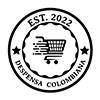Colombia!
FUN FACT: “Colombia” is a Latin word, which translates to the “Land of Columbus”, in honor of Christopher Columbus. It was invented by Francisco de Miranda, a Venezuelan who dreamed of establishing a Republic of Colombia which united all former Spanish colonies as a single nation.
Colombia is a South American nation, the only one with access to both the Pacific and Atlantic oceans. Its capital is Bogotá, and it has an estimated population of 50 million people. The dominant religion is Catholicism. Although its official language is Spanish and it is the language most people speak, there are over 70 other recognized indigenous languages spoken in the country.
Colombia is considered a “megadiverse” country, since 10% of the world’s biodiversity can be found within its borders. There are 314 types of ecosystems, with the most bird and orchid species in the world, as well as being the second for all plants, butterflies, freshwater fishes and amphibians. The country is politically divided into 32 departments, and geographically into 6 regions: Andean (mountainous), Caribbean (northern coast), Pacific (eastern coast), Orinoco (plains), Amazonas (jungle), and Insular (islands).
The regions known as Colombia and Panama today were colonized by Spain in the 16th century under the name of Viceroyalty of New Granada, officially established a few centuries later in 1717. It was originally inhabited by indigenous populations such as the Muisca, Quimbaya and Tairona, who have lived in the region for thousands of years. The arriving Spanish settlers brought Africans slaves with them, most of whom now live in the Pacific coast. All of these ethnic groups have mixed over the centuries, creating a rich culture with European, African, and Indigenous roots. Additionally, in the late 19th century and early 20th century, a wave of Ottoman immigrants entered the country, adding a Middle Eastern touch to Colombia. Shakira, one of Colombia’s best known artists, is a descendant of Lebanese immigrants.
Colombia’s first independence movement was led by Antonio Nariño in the 1790s, who, inspired by the French Revolution, began printing and distributing a translation of the “Declaration of the Right of Men”. Nariño consistently promoted equal rights for all men regardless of race, and the need of all Neogranadines to unite against Spanish oppression. He was captured by the Spanish and sent to a North African prison, however he managed to escape and return. In 1808 Spanish King Ferdinand VII was deposed by Napoleon after his invasion of Spain, and people began to be outspoken about independence. On July 20 of 1810, Colombia declared its independence. However, the independence movement was split and there was a civil war over whether the country would be a federation of states (like the United States) or a single state (like Colombia today) between 1812-1815. The civil war was cut short by a Spanish invasion, led by Pablo Morillo, who crushed the Neogranadine independence movement and executed most of the independence leaders, including Policarpa Salavarrieta (La Pola), Antonio Villavicencio, Camilo Torres Tenorio, Jorge Tadeo Lozano, Atanasio Girardot, and Francisco Jose de Caldas, among dozens more. Independence was eventually achieved in 1819, after the Battle of Boyaca, under the leadership of Simón Bolívar and Francisco de Paula Santander.
The first Republic of Colombia was established in 1821, and it was dissolved in 1832. It included the current territories of Panamá, Ecuador, Venezuela, and Colombia. Today it is better known as Greater Colombia or Gran Colombia. Regional leaders from Venezuela and Ecuador achieved independence for their territories. Panamá became independent in 1903 after the Thousand Days War, with an intervention from the United States to build the Panamá Canal. The Colombian Senate had favored the French to construct the canal.

